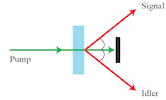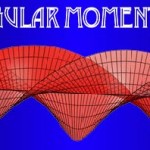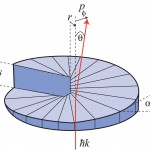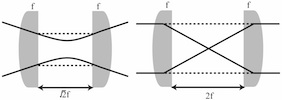Producing helically phased light
Light with OAM can be produced in a number of ways:
Spiral phase plates
An obvious approach to generating a helically phased beam is to pass a plane wave beam through an optical element with a helical surface, as shown here. The optical thickness of the component increases with azimuthal position according to mλθ/2π(n-1), where nis the refractive index of the medium. Unfortunately, despite the simplicity of the idea, at optical wavelengths this approach requires extreme precision in the pitch of helical surface.
Diffractive optical elements
Diffractive optical elements can be readily designed to mimic any refractive element of choice, at a single wavelength. A helical phase profile exp(imφ) converts a Gaussian laser beam into a helical mode. In practice, the phase distribution of the desired optical component is typically added to a linear phase ramp and the result is a diffraction grating that produces the desired beam in the first diffraction order.
The components are effectively holograms of the desired optical element and are thus often referred to as “computer generated holograms.” This approach is particularly appealing due to the commercial availability of spatial light modulators (SLMs). These are pixellated liquid crystal devices that can be programmed through the video interface of a computer to act as holograms. Changing their design is as simple as changing the image displayed by the computer interfacing the device.
Mode convertors
π/2 and π converters are used to combine a specific combination of Hermite–Gaussian modes to produce Laguerre–Gaussian modes [Beijersbergen 1993], as shown below, where three HG modes are combined to give the Laguerre–Gaussian mode LG02:
The π/2-converter transforms an incident HG mode into an LG mode while the π-converter transforms any mode into its own mirror image
Spontaneous parametric down-conversion (SPDC)

Pump photon is converted into 2 lower frequency photons.

Conservation of energy & momentum in SPDC.
Spontaneous parametric down-conversion (SPDC) is the generation of two lower- frequency photons when a pump field interacts with a nonlinear crystal. It is a conservative process: energy, momentum and orbital angular momentum are all conserved.
SPDC has been shown to be a reliable source of photons that are entangled [Hong 1985], in particular, in their OAM [Mair 2001]. The spatial structure of the down-converted biphotons can be expressed as a superposition of Laguerre–Gauss (LG) modes of different amplitudes, angular and radial momenta, with the width of the modal expansion relating to the amount of entanglement of the final state [Torres 2003; Miatto 2011; Yao 2011].




